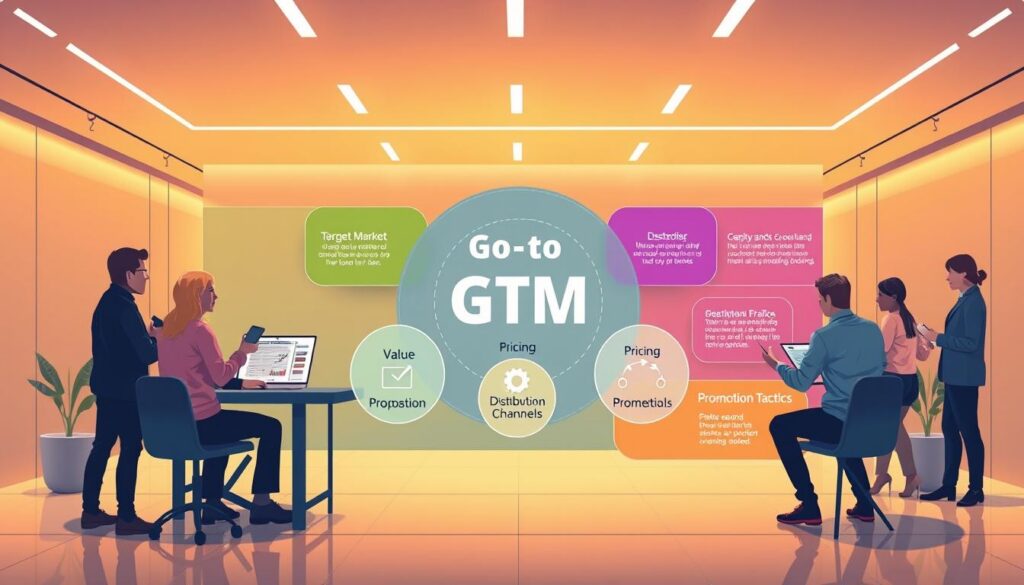In today’s fast-paced business environment, standing out requires more than just a great product. A well-crafted strategy bridges the gap between innovation and customer adoption, turning potential into measurable results. This is where a cohesive approach to commercializing offerings becomes critical.
Successful organizations align every function—from product design to sales—around a unified vision. They analyze market dynamics, customer pain points, and competitor moves to create tailored roadmaps. This coordination ensures consistent messaging and efficient resource allocation, which directly impacts revenue growth.
What separates leaders from followers? The ability to translate insights into action. A robust framework identifies ideal buyers, optimizes pricing models, and selects channels that maximize reach. It also anticipates challenges, from shifting regulations to emerging technologies, ensuring adaptability in complex B2B landscapes.
Key Takeaways
- Aligning business functions creates consistent customer experiences
- Market analysis drives smarter resource allocation
- Clear buyer profiles reduce acquisition costs
- Adaptive frameworks outperform rigid plans
- Cross-team collaboration accelerates product adoption
Understanding the Go-to-Market Strategy Landscape
The digital revolution has reshaped how businesses approach commercialization. Modern strategies now demand deeper analysis of buyer behavior and multi-layered decision-making processes. Companies that adapt thrive; those clinging to outdated methods risk irrelevance.
B2B purchasing decisions involve 6-10 stakeholders on average, per Gartner. This complexity requires tailored messaging for different roles – from technical evaluators to budget approvers. Effective plans map these interactions across digital and traditional channels.
| Traditional Approach | Modern GTM Strategy |
|---|---|
| Single decision-maker focus | Multi-stakeholder alignment |
| Linear sales funnels | Dynamic customer journeys |
| Annual planning cycles | Real-time optimization |
| Generic messaging | Personalized content streams |
Three factors separate winning strategies:
- Continuous data analysis for rapid adjustments
- Integration of AI-driven predictive modeling
- Cross-functional collaboration from launch through expansion
Leading organizations treat their strategy as living documentation. They update tactics weekly based on performance metrics and emerging market signals. This agility helps maintain relevance in volatile sectors.
What is a Go-to-Market (GTM) Strategy?
Business success increasingly depends on meticulous planning that bridges internal capabilities with external opportunities. A GTM strategy acts as this crucial bridge – a detailed action plan for delivering products to specific audiences effectively. Unlike generic business plans, it coordinates every team from development to support around measurable outcomes.

| Element | Purpose |
|---|---|
| Market Definition | Identifies high-potential segments |
| Customer Profiling | Details buyer behaviors & needs |
| Distribution Model | Optimizes delivery channels |
| Product Positioning | Articulates unique value |
| Pricing Structure | Balances competitiveness & profit |
Companies using formalized strategies achieve 30% faster revenue growth according to recent industry studies. The approach aligns sales tactics with marketing campaigns while informing product roadmaps. As one tech executive noted:
“Our GTM plan became the playbook that synchronized previously siloed departments.”
Modern implementations must address complex buyer journeys. Over 70% of B2B purchases now involve four+ decision-makers across multiple platforms. Effective strategies map these interactions, ensuring consistent messaging through every touchpoint – from social media to direct sales conversations.
This coordination reduces launch risks while accelerating customer acquisition. Teams gain clarity on resource allocation, campaign timing, and performance metrics. The result? Products reach ideal buyers faster, with messaging that resonates at each decision stage.
The Role of Go to Market Positioning in Your Overall Strategy
Successful commercialization requires more than product excellence—it demands a strategy that bridges vision with execution. Positioning acts as the compass guiding every decision, from feature prioritization to campaign design. Teams that master this alignment see 27% faster revenue growth than competitors, according to recent B2B benchmarks.
This approach transforms how organizations operate. It synchronizes sales collateral with marketing narratives while informing product roadmaps. When engineering builds features that address validated pain points, and customer success teams reinforce those solutions, companies create self-reinforcing value cycles.
Three critical functions emerge from strategic alignment:
- Eliminating internal miscommunication about core differentiators
- Focusing R&D budgets on market-proven enhancements
- Enabling consistent messaging across digital and in-person channels
A well-designed GTM strategy prevents wasted efforts. For example, a SaaS company reduced customer acquisition costs by 40% after mapping feature development to specific buyer roles. Their product team prioritized integrations that addressed procurement officers’ compliance concerns—a need revealed through positioning analysis.
The true power lies in adaptability. Markets shift, but anchored positioning allows quick pivots without losing strategic direction. Teams maintain clarity on what makes their solution unique, even when adjusting tactics for new regions or verticals. This flexibility proves vital in industries where regulatory changes occur quarterly.
Organizations that treat positioning as dynamic—not static—achieve sustainable growth. They update their playbooks based on real-time market feedback, ensuring every department contributes to measurable outcomes. The result? Products that don’t just enter markets—they redefine them.
Identifying Your Ideal Customer Profile
Understanding your audience is the cornerstone of effective market strategies. The ideal customer profile (ICP) pinpoints businesses most likely to benefit from your solution. Gartner reveals complex B2B purchases involve 6-10 decision-makers, creating a “buying center” with distinct roles.

Building an ICP requires blending firmographic data with behavioral insights. Quantitative metrics like company size and revenue identify potential targets. Qualitative factors – such as technology adoption patterns – reveal readiness to buy. This dual approach helps teams allocate resources efficiently.
| Buying Role | Key Responsibility |
|---|---|
| Initiator | Starts evaluation process |
| User | Operates solution daily |
| Influencer | Shapes internal opinions |
| Decision Maker | Approves final purchase |
| Gatekeeper | Controls implementation access |
Effective profiling digs deeper than job titles. It examines budget cycles, decision timelines, and pain points driving purchases. For example, a manufacturing company might prioritize safety compliance over cost savings when selecting vendors.
Organizations using precise ICPs see 35% higher conversion rates according to recent studies. Developing a targeted profile informs every strategy element – from product features to sales scripts. This focus prevents wasted efforts on mismatched prospects.
The result? Shorter sales cycles and customers who become long-term partners. By aligning offerings with specific needs, businesses create self-sustaining growth engines powered by strategic targeting.
Researching Target Audience and Uncovering Pain Points
Effective commercialization starts with understanding your audience’s core challenges. Businesses that master target audience research reduce customer acquisition costs by 19% while improving conversion rates, according to Gartner analysis. This requires moving beyond demographics to uncover operational friction points that drive purchasing decisions.
| Area | Research Focus | Impact Potential |
|---|---|---|
| Budget | Waste patterns & optimization triggers | 28% cost reduction avg. |
| People | Daily workflow bottlenecks | 41% efficiency gains |
| Process | Systematic breakdown points | 35% faster execution |
| Productivity | Resource allocation gaps | 22% output increase |
| Support | Buying cycle friction | 53% retention boost |
Advanced techniques blend behavioral analytics with direct interviews. One healthcare SaaS company discovered 63% of clients struggled with compliance workflows – a pain point hidden in support ticket patterns. This insight reshaped their entire customer onboarding process.
Quantitative data reveals market trends, while qualitative methods expose emotional drivers. Successful teams use:
- Competitor case study analysis
- Real-time usage pattern tracking
- Decision-maker role mapping
Organizations conducting continuous pain point research adapt messaging 3x faster during economic shifts. They create content that addresses specific departmental needs – from IT security concerns to CFO-level ROI demands.
This approach transforms generic solutions into must-have tools. By linking product features to measurable outcomes, businesses build campaigns that cut through noise and drive action.
Developing a Winning GTM Strategy Framework
Building an effective commercialization blueprint demands precision in identifying opportunities and threats. The GTM Operating System from GTM Partners outlines eight pillars for success, emphasizing structured analysis and adaptable execution. This approach transforms raw data into actionable insights that drive measurable outcomes.
Market Sizing and Segmentation
Successful frameworks use tiered market evaluation to balance ambition with realism. The four-layer model helps teams prioritize effectively:
| Metric | Focus | Impact |
|---|---|---|
| TAM | Total market potential | Strategic vision setting |
| SAM | Realistic service area | Resource allocation |
| SOM | Achievable targets | Short-term KPIs |
| PAM | High-priority accounts | Immediate conversions |
Segmentation then breaks these layers into actionable groups. Analyzing purchase behaviors and operational needs allows tailored messaging. For example, a healthtech company might target compliance-focused hospitals differently than cost-driven clinics.
Conducting Competitive Analysis
Understanding rivals requires examining three dimensions:
- Feature parity gaps in core product offerings
- Pricing elasticity across customer tiers
- Brand perception in key verticals
One enterprise software provider discovered competitors undervalued implementation support. They repositioned as “implementation partners,” boosting close rates by 22%. Regular analysis ensures strategies stay ahead of market shifts rather than reacting to them.
The strongest frameworks combine external insights with internal capability audits. This alignment prevents overextension while highlighting areas needing investment. Teams gain clarity on where to compete – and how to win.
Crafting a Distinctive Value Proposition and Messaging
Transforming buyer insights into compelling narratives separates market leaders from followers. A value proposition built on precise customer needs cuts through noise, directly addressing what decision-makers prioritize. This requires translating personas into actionable frameworks that bridge problems with solutions.
From Data to Dialogue
The value matrix method maps each role’s challenges to specific product benefits. For example, a procurement officer’s compliance concerns might align with automated audit trails, while end-users prioritize interface simplicity. Each connection demands tailored messaging that speaks to immediate needs.
Effective communication mirrors how people solve problems. Decision-makers often seek “painkillers” over “vitamins” – solutions addressing urgent issues rather than preventative measures. Framing your offering as the remedy requires a deep understanding of customer motivations behind their search for answers.
Consistency across channels reinforces credibility. Sales scripts, website copy, and support materials should all echo the core value proposition. This alignment shortens decision cycles by 34% in complex B2B environments, according to recent analyst reports.
Regularly test messages against evolving market conditions. What resonates today may miss tomorrow’s emerging priorities. Agile teams adapt their messaging using real-time feedback, ensuring relevance as buyer needs shift.
FAQ
How does go-to-market positioning differ from general marketing strategy?
Go-to-market positioning specifically focuses on how a product/service enters a market and competes within defined parameters. Unlike broader marketing strategies, it combines product-market fit analysis, distribution channel selection, and customer acquisition tactics into an operational blueprint.
What makes an ideal customer profile actionable for GTM execution?
Actionable profiles combine firmographic data (company size/industry) with behavioral insights (purchasing patterns) and pain point validation. HubSpot’s ICP framework demonstrates this by aligning sales/marketing teams around measurable criteria like budget ownership and decision-making timelines.
Can startups use enterprise-level GTM strategies effectively?
While enterprise strategies emphasize complex sales cycles, startups adapt core principles through lean validation. Dropbox’s early viral loop strategy maintained enterprise-grade positioning (secure file sharing) while using freemium models tailored to SMB adoption curves.
How do pain points influence value proposition development?
Documented pain points directly shape messaging hierarchy. Salesforce structures its “No Software” campaign around eliminating legacy system frustrations, proving how solution-centric narratives outperform feature lists when addressing verified customer challenges.
When should companies revise their GTM strategy?
Key revision triggers include entering new markets (Zoom expanding into phone systems), product pivots (Slack shifting from gaming to collaboration), or sustained conversion rate declines. Quarterly performance reviews against KPIs help identify necessary adjustments.
What metrics prove GTM strategy effectiveness?
Beyond revenue, track customer acquisition cost payback period, product-qualified lead velocity, and net promoter score. Twilio’s developer-focused GTM success shows how measuring API adoption rates and partner ecosystem growth provides strategic validation.



